Thursday 14th March 2019
It began a month ago. A day out to Norwich to travel route 88 via Bungay and Halesworth to Southwold, where I’d catch the four-journey-a-day tendered route 90 which returns to Halesworth via a very circuitous route through some delightful Suffolk villages as well as the small town of Beccles. Both routes were formerly operated by Anglian Bus until the more recent decision by owners Go-Ahead to phase out that company name and brand in favour of neighbouring Konectbus. News had come that Konectbus had given notice to withdraw the 88 from 1st March following a resurgent First Bus competing on the route between Norwich and Bungay and “sustained losses of several million pounds on our Beccles based operations in the last few years”.
Evening and Sunday journeys are tendered by Norfolk County Council with the section of route between Halesworth and Southwold on the 88, as well as the entire 90, being Suffolk tenders so these needed longer notice periods and are continuing until the end of this month (the tendered bit of route 88) or Easter (route 90).
 Intrigued by all this I headed off to Norwich to investigate. In the event things didn’t work out as planned. The journey I planned to catch on the 88 at 1205 from Norwich was cancelled at short notice due to staff sickness meaning an hours delay and a missed connection in Southwold to the infrequent route 90.
Intrigued by all this I headed off to Norwich to investigate. In the event things didn’t work out as planned. The journey I planned to catch on the 88 at 1205 from Norwich was cancelled at short notice due to staff sickness meaning an hours delay and a missed connection in Southwold to the infrequent route 90.
I quickly abandoned the idea of reaching Southwold, took the next 88 as far as Halesworth, and returned home by train from there. The enforced delay in Norwich gave me a chance to assess how Konectbus (and the former Anglian Bus) are doing some years on from Go-Ahead’s acquisitions in March 2010 and April 2012 respectively and inspired me to make plans for a longer return visit to further investigate bus operations in this part of East Anglia, which I was able to achieve this week.
This blog summarises my findings.
1. What are Go-Ahead doing in East Anglia anyway?
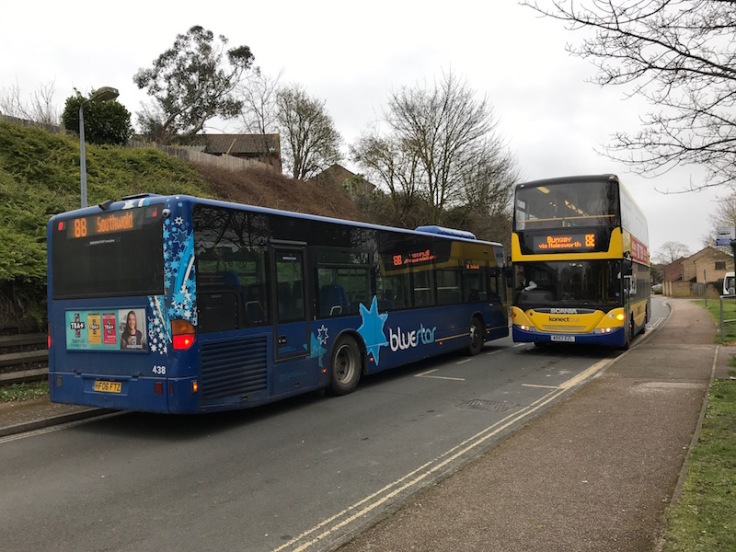 It’s not surprising the wheels are coming off. The post deregulation history of PLC transport groups in East Anglia is not encouraging. First Bus have struggled for years throughout the region. Their Essex operations are down-at-heel befitting the struggling finances. Norwich based operations are looking better than for many a year (and amazingly now seeing off Go-Ahead on the 88) but they gave up on large parts of Suffolk and Norfolk years ago. Stagecoach tried its hand and failed spectacularly with Norfolk Green.
It’s not surprising the wheels are coming off. The post deregulation history of PLC transport groups in East Anglia is not encouraging. First Bus have struggled for years throughout the region. Their Essex operations are down-at-heel befitting the struggling finances. Norwich based operations are looking better than for many a year (and amazingly now seeing off Go-Ahead on the 88) but they gave up on large parts of Suffolk and Norfolk years ago. Stagecoach tried its hand and failed spectacularly with Norfolk Green.
When the talk was a possible sale of municipally owned Ipswich Buses in the early 2010s it may have made sense for Go-Ahead to buy up a few small independents to build a presence in the region in preparation for a bid. A decade on it makes no sense to be running low margin tendered work at all. To be running substantial loss making operations in a largely rural area remote from other Go-Ahead operations is a complete nonsense.
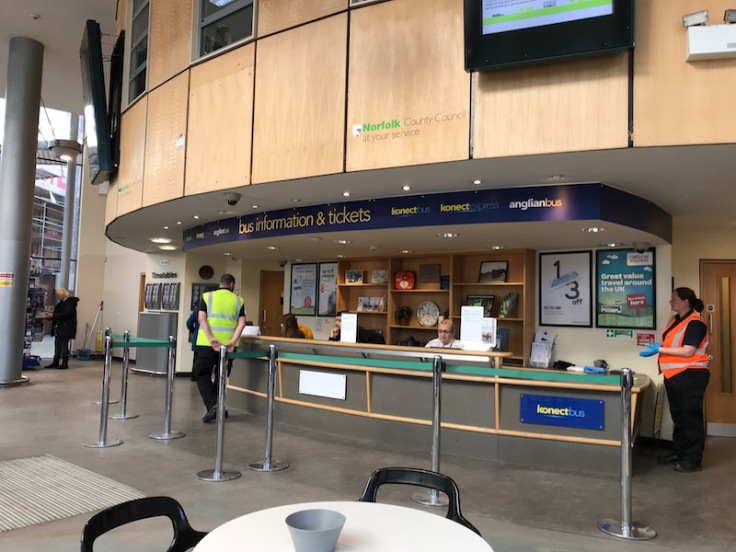
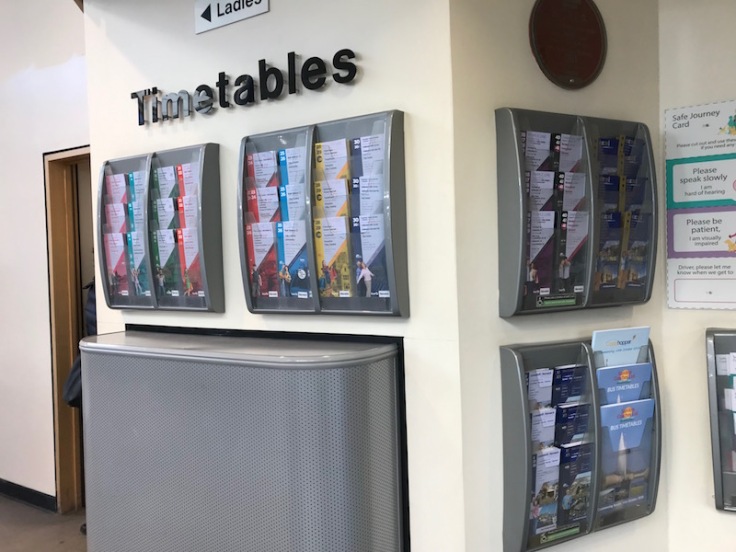 What’s more, the image doesn’t look good either. On the positive side the Travel Centre in Norwich bus station, staffed by Konectbus, looks smart and offers an impressive display of timetables covering all bus operators in the city, as does the Norwich Park and Ride operation but the state of the Company’s vehicles on other routes is anything but smart and leaves much to be desired.
What’s more, the image doesn’t look good either. On the positive side the Travel Centre in Norwich bus station, staffed by Konectbus, looks smart and offers an impressive display of timetables covering all bus operators in the city, as does the Norwich Park and Ride operation but the state of the Company’s vehicles on other routes is anything but smart and leaves much to be desired.
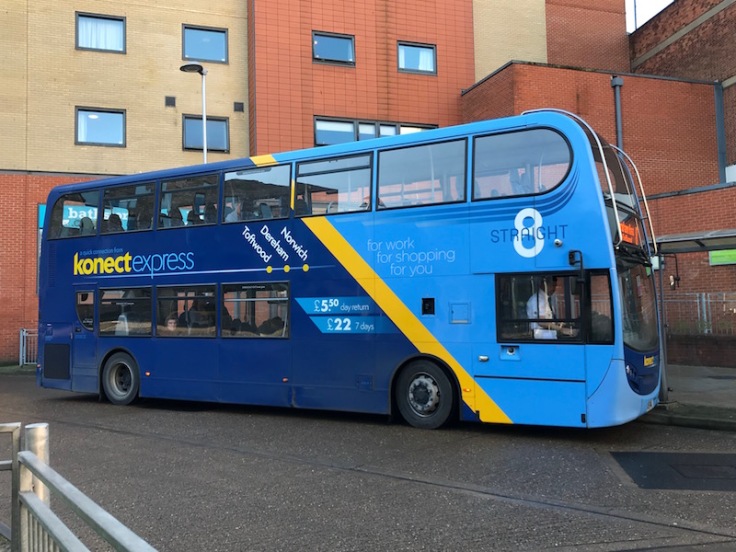 With one exception shown above (indicating the bus wash must have been working), buses were filthy and unattractive. Some were still in Bluestar livery which must look odd to passengers unaware of that award winning sister Go-Ahead company on the south coast. The image portrayed reminded me of a down-at-heel small time bus operator on the verge of going out of business rather than a subsidiary of a well regarded aspirational multi national transport group quoted on the stock market proud of its reputation. Shareholders wouldn’t be proud of this image nor should management.
With one exception shown above (indicating the bus wash must have been working), buses were filthy and unattractive. Some were still in Bluestar livery which must look odd to passengers unaware of that award winning sister Go-Ahead company on the south coast. The image portrayed reminded me of a down-at-heel small time bus operator on the verge of going out of business rather than a subsidiary of a well regarded aspirational multi national transport group quoted on the stock market proud of its reputation. Shareholders wouldn’t be proud of this image nor should management.
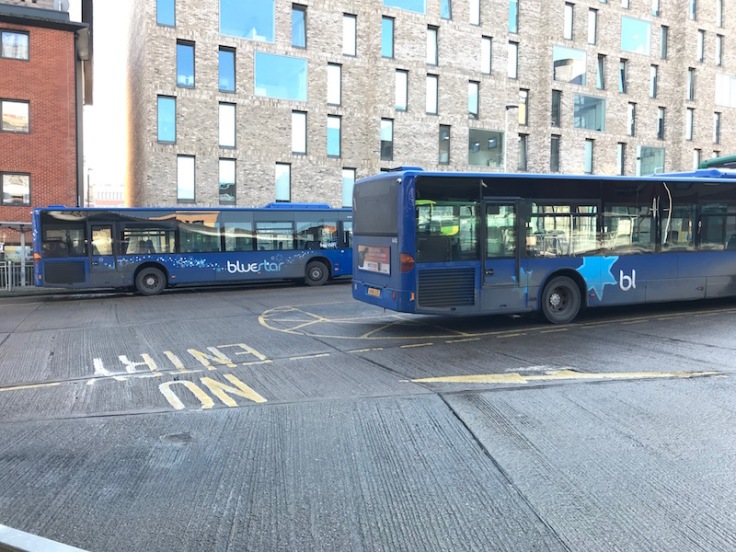
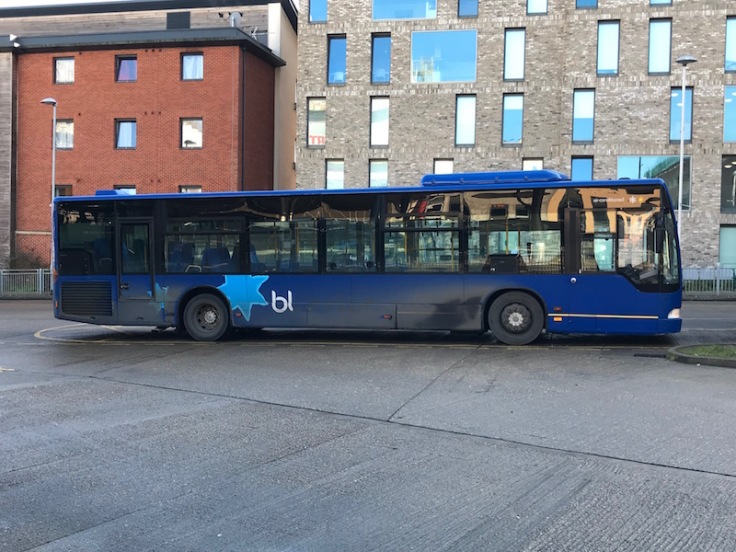
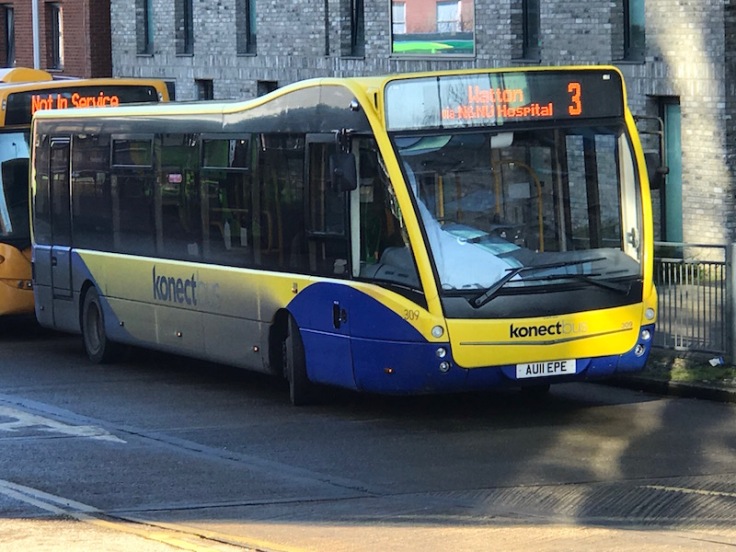 My next departure at 1305 on the 88 on my aborted day trip unimpressively left late because the driver failed to turn up on time meaning passengers experienced well over an hour to wait and of course there was a double load to load too, and for a route in its last couple of weeks operation was actually quite a decent load.
My next departure at 1305 on the 88 on my aborted day trip unimpressively left late because the driver failed to turn up on time meaning passengers experienced well over an hour to wait and of course there was a double load to load too, and for a route in its last couple of weeks operation was actually quite a decent load.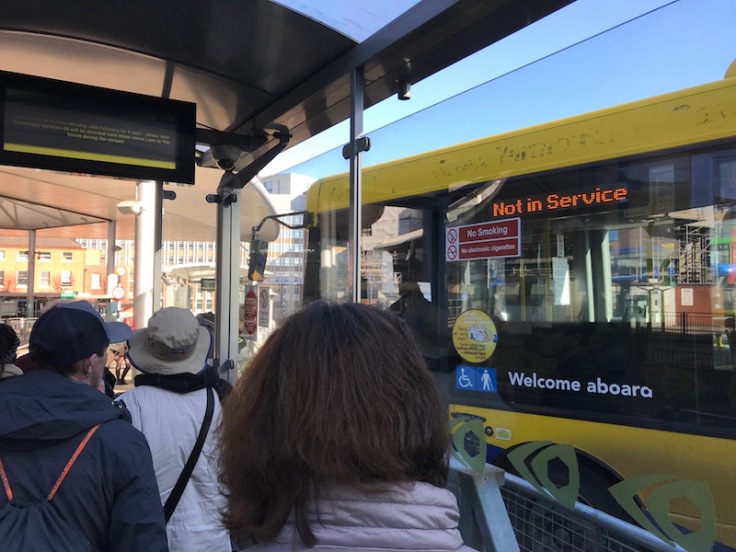
 Down in north Essex and south Suffolk Go-ahead owned Hedingham and Chambers (also both acquired in the 2012 Anglian buying spree) present a smarter image but there are odd inconsistencies in corporate livery. Despite my keen interest in these things I was confused what each brand/company was supposed to look like or whether they were supposed to look the same; goodness knows what passengers and potential passengers think. It’s a complete muddle.
Down in north Essex and south Suffolk Go-ahead owned Hedingham and Chambers (also both acquired in the 2012 Anglian buying spree) present a smarter image but there are odd inconsistencies in corporate livery. Despite my keen interest in these things I was confused what each brand/company was supposed to look like or whether they were supposed to look the same; goodness knows what passengers and potential passengers think. It’s a complete muddle.
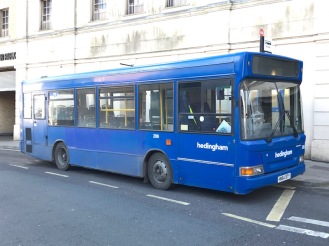
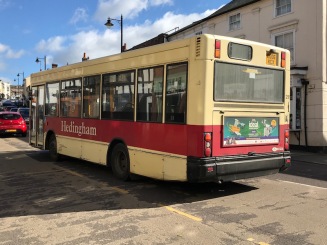

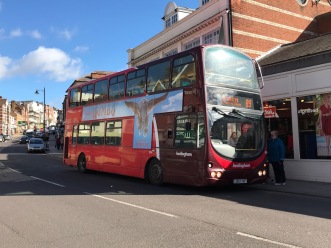 The Chambers operated 753/754 trunk route between Colchester, Sudbury and Bury St Edmunds seems well run as does the Hedingham run 88 (yes, another 88) between Colchester and Halstead (in a long standing joint operation with First Bus – from the days of Eastern Counties and Hedingham working together) and route 89 between Halstead and Braintree all of which I sampled, but these routes will never be double digit profit margin bankers for a PLC.
The Chambers operated 753/754 trunk route between Colchester, Sudbury and Bury St Edmunds seems well run as does the Hedingham run 88 (yes, another 88) between Colchester and Halstead (in a long standing joint operation with First Bus – from the days of Eastern Counties and Hedingham working together) and route 89 between Halstead and Braintree all of which I sampled, but these routes will never be double digit profit margin bankers for a PLC. My advice to Go-Ahead is to get First Bus to agree a couple of hundred grand off the price of Manchester Queens Road and throw this lot in as part of a transfer deal. It would make for a sensible ‘Withdrawal Deal’ for Go-Ahead in Anglia. Another exit strategy would ironically be to sell the former independently operated routes back to, err, an independent operator (see below).
My advice to Go-Ahead is to get First Bus to agree a couple of hundred grand off the price of Manchester Queens Road and throw this lot in as part of a transfer deal. It would make for a sensible ‘Withdrawal Deal’ for Go-Ahead in Anglia. Another exit strategy would ironically be to sell the former independently operated routes back to, err, an independent operator (see below).
2. A mixed First Bus bag
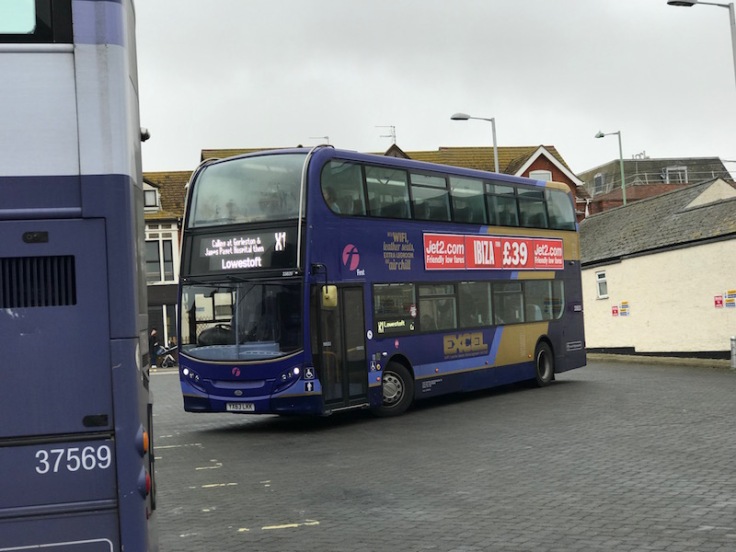 I mentioned above that First Bus seem to have got their act together in Norwich now looking smarter and presentable. The high profile excel ‘X1’ route at one time from Peterborough to Lowestoft, now split into manageable sections, still brings quality looking buses into Great Yarmouth and Lowestoft. While at one time Anglian Bus seemed to be running rings around First Bus on the Norwich, Beccles, Lowestoft corridor nowadays First’s X2 (fast) and X22 (via Loddon) provide four buses an hour (two on each route) making for a decent service which seemed well used on my travels.
I mentioned above that First Bus seem to have got their act together in Norwich now looking smarter and presentable. The high profile excel ‘X1’ route at one time from Peterborough to Lowestoft, now split into manageable sections, still brings quality looking buses into Great Yarmouth and Lowestoft. While at one time Anglian Bus seemed to be running rings around First Bus on the Norwich, Beccles, Lowestoft corridor nowadays First’s X2 (fast) and X22 (via Loddon) provide four buses an hour (two on each route) making for a decent service which seemed well used on my travels.
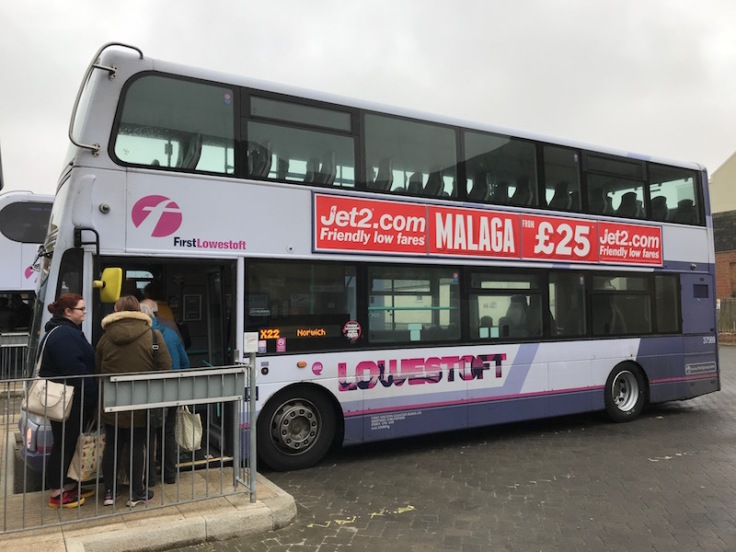 Lowestoft has always seemed to be low down the First Bus priority list whenever I’ve visited and this time was no exception.
Lowestoft has always seemed to be low down the First Bus priority list whenever I’ve visited and this time was no exception.

 The hourly route 99 down to Kessingland and Southwold was characteristically operated by ‘W’ registration double deckers dating from 2000 giving a travel experience befitting of the east coast resort’s dated image.
The hourly route 99 down to Kessingland and Southwold was characteristically operated by ‘W’ registration double deckers dating from 2000 giving a travel experience befitting of the east coast resort’s dated image.
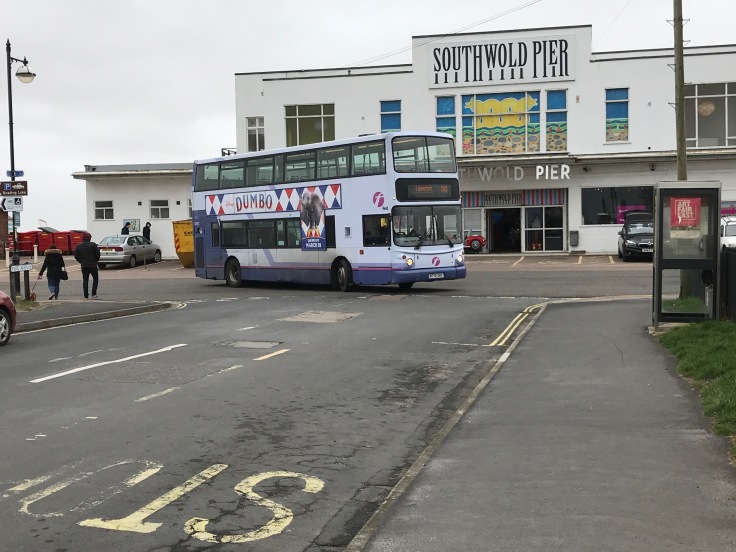 The bespoke livery variation used in Ipswich looks smarter than plain First Bus colours, if a bit dull, but with seat backs also branded for these operations I fail to understand the logic of where local branding fits into the First Bus strategy. There was a time Corporate HQ told us it was essential to have a nationwide corporate livery so that buses could easily and cost effectively be transferred around the country as needed (in addition to satisfying Aberdeen’s corporate ego). So what’s with the bespoke seats then?
The bespoke livery variation used in Ipswich looks smarter than plain First Bus colours, if a bit dull, but with seat backs also branded for these operations I fail to understand the logic of where local branding fits into the First Bus strategy. There was a time Corporate HQ told us it was essential to have a nationwide corporate livery so that buses could easily and cost effectively be transferred around the country as needed (in addition to satisfying Aberdeen’s corporate ego). So what’s with the bespoke seats then?

 It would be so much better if those Aberdeen control freaks just empowered managing directors to reintroduce proper local branding and really show what could be achieved in tune with the Anglian market.
It would be so much better if those Aberdeen control freaks just empowered managing directors to reintroduce proper local branding and really show what could be achieved in tune with the Anglian market.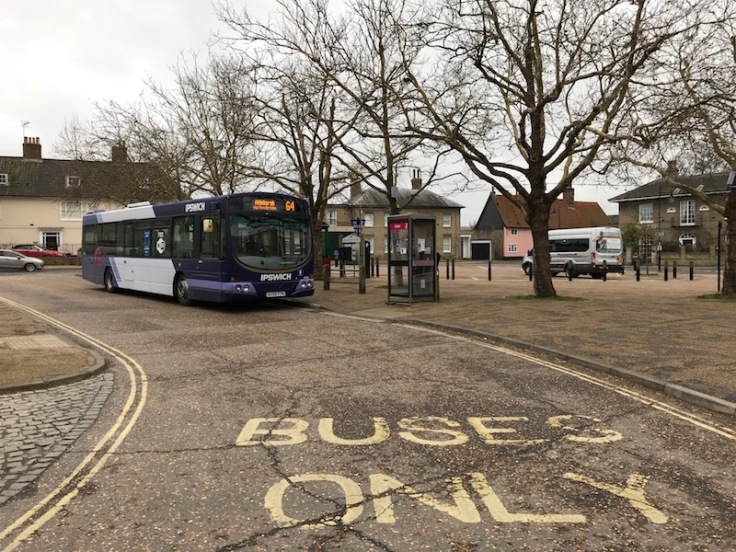 Sadly First Bus still leave a lot to be desired when it comes to detail. I wasn’t impressed catching the early morning 0615 departure on route 64 from Ipswich to Aldeburgh after initially being reassured to find the bus already screened up and waiting on stand soon after 0600 only to find the driver saunter up to the bus at 0622 and load the six of us boarding, one of whom told me it happens every day.
Sadly First Bus still leave a lot to be desired when it comes to detail. I wasn’t impressed catching the early morning 0615 departure on route 64 from Ipswich to Aldeburgh after initially being reassured to find the bus already screened up and waiting on stand soon after 0600 only to find the driver saunter up to the bus at 0622 and load the six of us boarding, one of whom told me it happens every day. 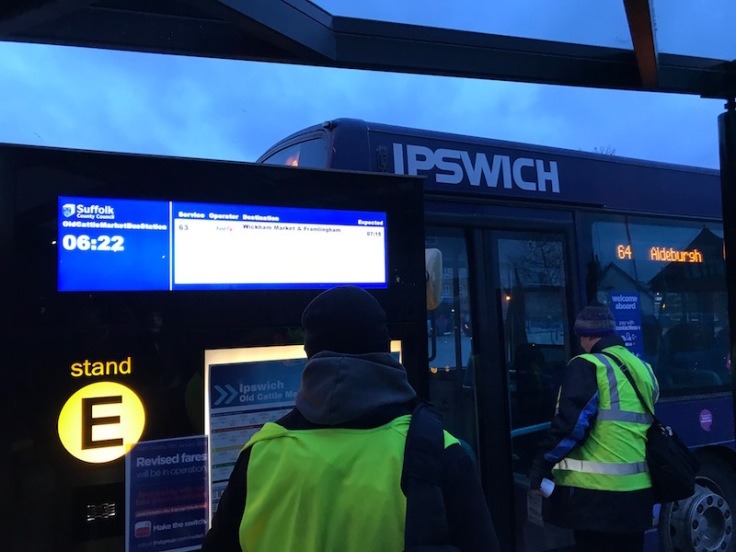 We finally left ten minutes late at 0625 but by Woodbridge were already ahead of scheduled time so waited four minutes there, a further five minute wait at Wickham Market and finally arrived Southwold two minutes early.
We finally left ten minutes late at 0625 but by Woodbridge were already ahead of scheduled time so waited four minutes there, a further five minute wait at Wickham Market and finally arrived Southwold two minutes early.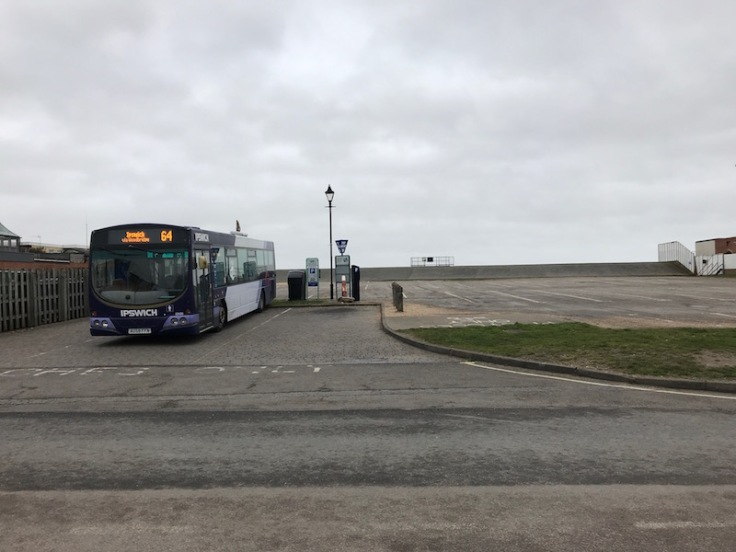 You can easily take twenty minutes out of the scheduled time for that journey and stop regular passengers having to wait on a cold windy morning for the bus doors to open at the bus station. I tweeted this experience to First’s centralised tweeting operation; obviously didn’t receive any reply or apology, not even an acknowledgement. Frankly a contemptuous way to treat passengers.
You can easily take twenty minutes out of the scheduled time for that journey and stop regular passengers having to wait on a cold windy morning for the bus doors to open at the bus station. I tweeted this experience to First’s centralised tweeting operation; obviously didn’t receive any reply or apology, not even an acknowledgement. Frankly a contemptuous way to treat passengers.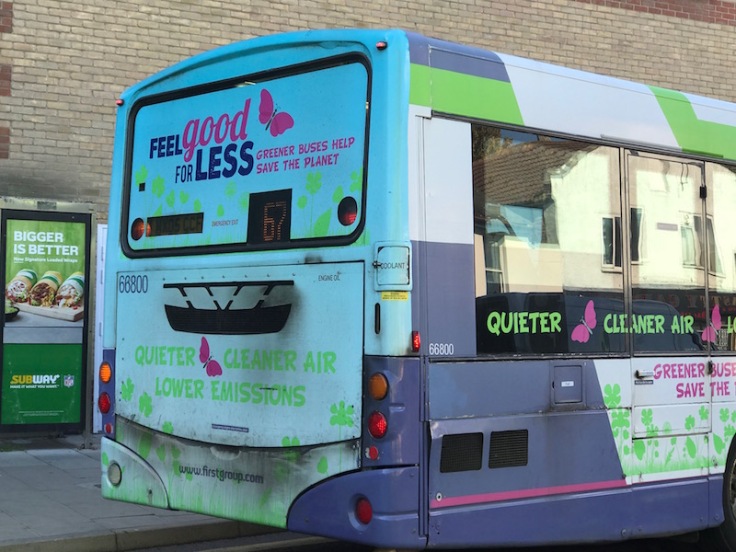 The general impression of buses around Colchester is poor. Neither First Bus or Arriva’s presence in the town is particularly dynamic and enticing.
The general impression of buses around Colchester is poor. Neither First Bus or Arriva’s presence in the town is particularly dynamic and enticing. 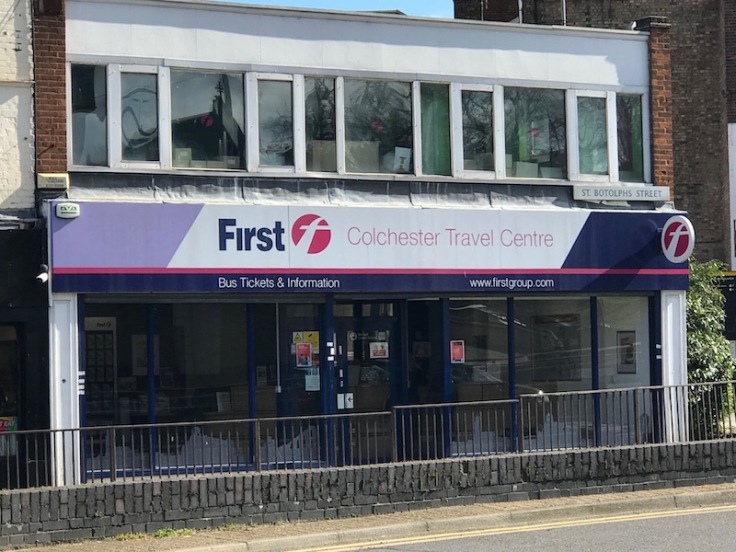 The bright spot is the First Bus run Travel Centre located fairly close to the main departure bus stops in Osborne Street. It contains an impressive display of timetable leaflets and even a network route map displayed on the wall (albeit requiring a minor updating, but at least this was admitted by way of a piece of paper stick to it).
The bright spot is the First Bus run Travel Centre located fairly close to the main departure bus stops in Osborne Street. It contains an impressive display of timetable leaflets and even a network route map displayed on the wall (albeit requiring a minor updating, but at least this was admitted by way of a piece of paper stick to it).

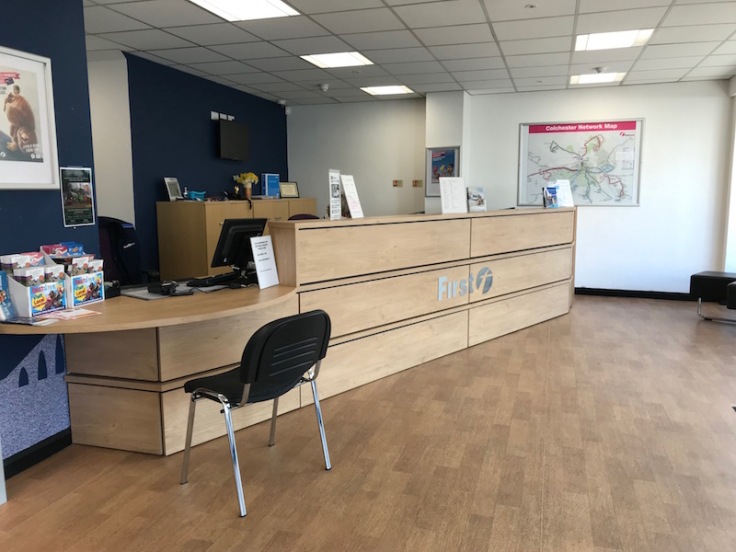 What would really be helpful for passengers is timetables for routes run by other operators to also be displayed. I didn’t visit the First Bus Travel Centre in Norwich this time, but suspect the same policy holds good there too. It wouldn’t cost anything and would do a huge amount to promote public transport use overall, instead of making it so hard for passengers to obtain information.
What would really be helpful for passengers is timetables for routes run by other operators to also be displayed. I didn’t visit the First Bus Travel Centre in Norwich this time, but suspect the same policy holds good there too. It wouldn’t cost anything and would do a huge amount to promote public transport use overall, instead of making it so hard for passengers to obtain information.
First Bus are stepping in to cover the withdrawal of the tendered part of Konectbus 88 by extending their Lowestoft to Southwold route 99 (to be numbered 99A) on to Halesworth and Bungay where there will be connections to their commercial route to Norwich. The wheel really has turned full circle here with First Bus, or Eastern Counties, as it was, now regaining territory ceded to Anglian Bus, acquired by Go-Ahead and now throwing in the towel. Talking of Anglian Bus….
3. Active Anglian Independents

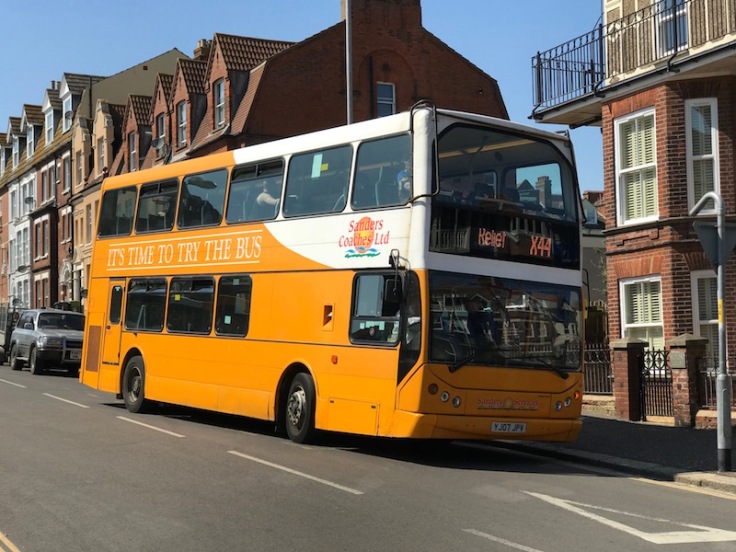 East Anglia is fortunate in having a good selection of quality independently owned small bus companies providing key routes across the region. From the expanding Stephensons in the south of the region to Sanders Coaches in the north and many more in the middle.
East Anglia is fortunate in having a good selection of quality independently owned small bus companies providing key routes across the region. From the expanding Stephensons in the south of the region to Sanders Coaches in the north and many more in the middle.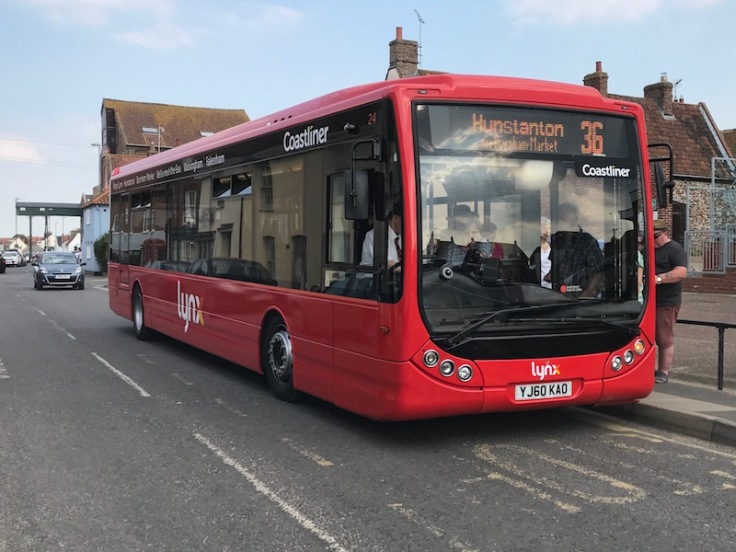
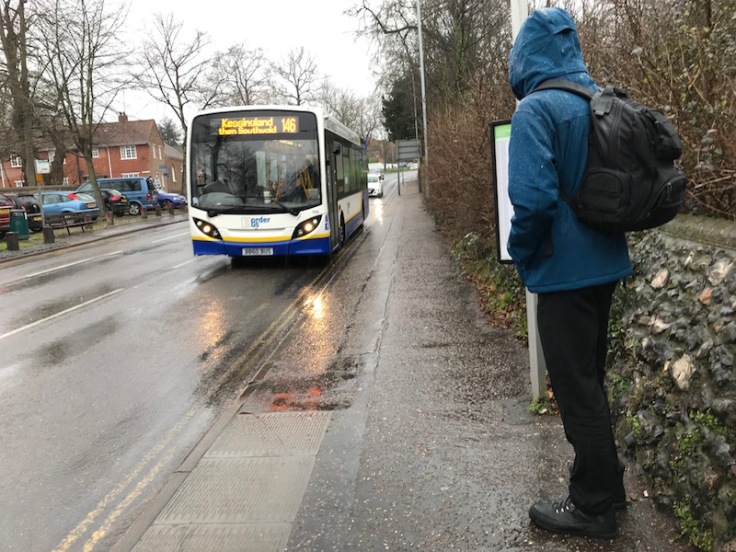 Julian Paterson, formerly of Konectbus now owns and runs the excellent Lynx in West Norfolk while Andrew Pursey formerly of Anglian Bus has started and runs Border Bus. I travelled on two of their three routes during my visit this week, the tendered four-journey-a day 521 between Aldburgh and Halesworth and the hourly (with extra morning journeys making for half hourly) 146 running fast between Norwich and Beccles where it competes with the already mentioned First Bus operated X2 and X22. It then continues to Carlton Coalville and Kessingland on the outskirts of Lowestoft before terminating in Southwold.
Julian Paterson, formerly of Konectbus now owns and runs the excellent Lynx in West Norfolk while Andrew Pursey formerly of Anglian Bus has started and runs Border Bus. I travelled on two of their three routes during my visit this week, the tendered four-journey-a day 521 between Aldburgh and Halesworth and the hourly (with extra morning journeys making for half hourly) 146 running fast between Norwich and Beccles where it competes with the already mentioned First Bus operated X2 and X22. It then continues to Carlton Coalville and Kessingland on the outskirts of Lowestoft before terminating in Southwold. The lunch time journey I travelled on out of Norwich had a good seated load of twenty with around a third getting off in Beccles, half in Kessingland and just a smattering travelling all the way to Southwold. The 521 was less busy. In fact it was dire, which brings me to….
The lunch time journey I travelled on out of Norwich had a good seated load of twenty with around a third getting off in Beccles, half in Kessingland and just a smattering travelling all the way to Southwold. The 521 was less busy. In fact it was dire, which brings me to….
4. Suffolk County Council
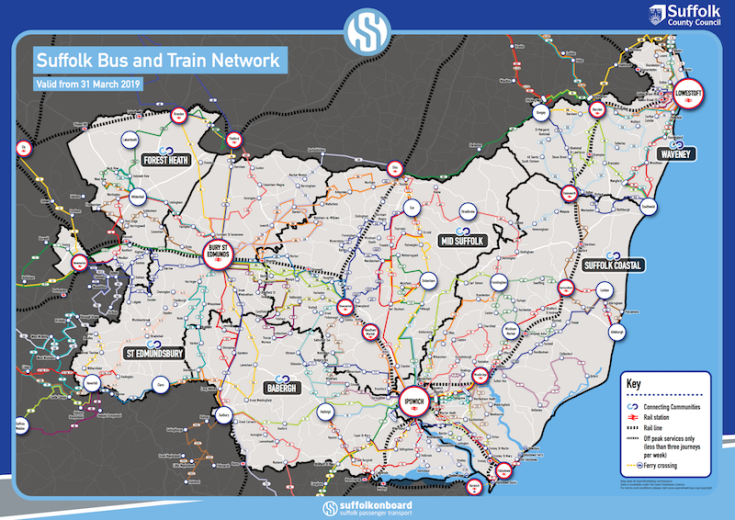 I spent most of my time this week exploring Suffolk as well as in northern Essex with only shorter incursions into Norfolk. Suffolk is a delightfuly county but with many transport challenges not least the very low density of population. Aside from Ipswich and Lowestoft and their environs, and the smaller market towns of Beccles, Bungay, Bury St Edmunds, Halesworth, Saxmundham, Stowmarket, Sudbury and Wickham Market, away from the coastal communities of Aldeburgh and Southwold the county is characterised by hundreds of tiny hamlets connected only by circuitous narrow country roads. The rural transport challenge for the county is therefore huge, not helped by Suffolk deciding to save 20% of its £1.7million budget from April.
I spent most of my time this week exploring Suffolk as well as in northern Essex with only shorter incursions into Norfolk. Suffolk is a delightfuly county but with many transport challenges not least the very low density of population. Aside from Ipswich and Lowestoft and their environs, and the smaller market towns of Beccles, Bungay, Bury St Edmunds, Halesworth, Saxmundham, Stowmarket, Sudbury and Wickham Market, away from the coastal communities of Aldeburgh and Southwold the county is characterised by hundreds of tiny hamlets connected only by circuitous narrow country roads. The rural transport challenge for the county is therefore huge, not helped by Suffolk deciding to save 20% of its £1.7million budget from April.
I read about discontentment with proposals to withdraw some off peak journeys on routes 112/113 which run from Diss (just over the border in Norfolk) to Ipswich operated by Galloway Travel Group (who run extensive coach tours and excursions as well as some local bus routes).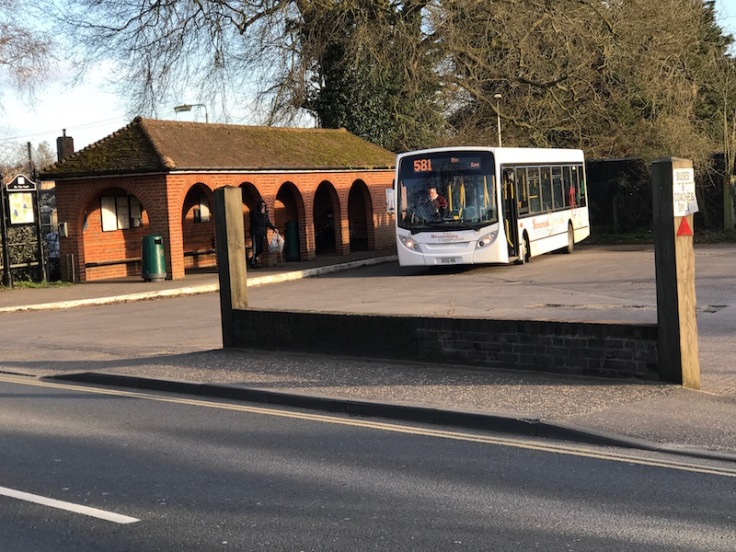 Apparently off peak journeys are at risk but I travelled on one of the few peak hour journeys leaving Diss at 1655 and arriving Ipswich at 1808. A deadly quiet Diss bus station is pictured above at 1645 approaching the evening peak. Three passengers boarded with me at Diss all travelling to the village of Eye just thirteen minutes south. For the next hour and four minutes until we reached Ipswich it was just me and the driver.
Apparently off peak journeys are at risk but I travelled on one of the few peak hour journeys leaving Diss at 1655 and arriving Ipswich at 1808. A deadly quiet Diss bus station is pictured above at 1645 approaching the evening peak. Three passengers boarded with me at Diss all travelling to the village of Eye just thirteen minutes south. For the next hour and four minutes until we reached Ipswich it was just me and the driver.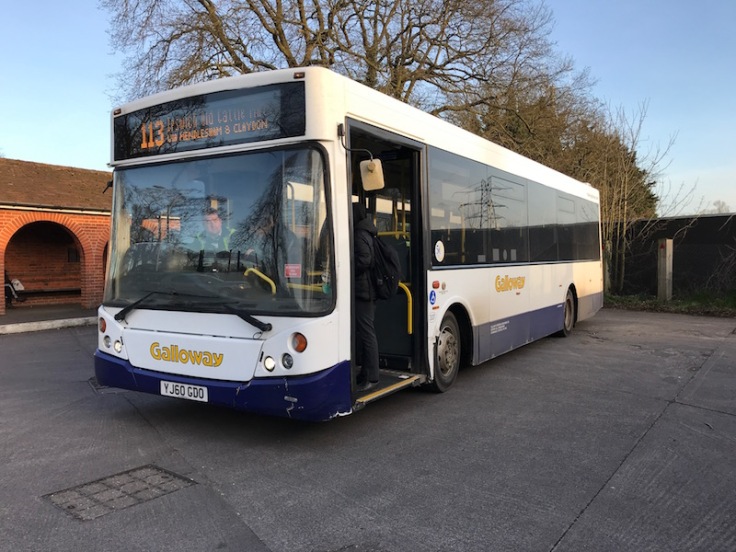 It’s not cuts to rural bus routes leaving passengers isolated, its passengers deserting buses leaving the buses isolated and running empty. My journey on the Border Bus operated tendered route 521 at 0855 from Aldeburgh to Halesworth was similarly sparsely loaded.
It’s not cuts to rural bus routes leaving passengers isolated, its passengers deserting buses leaving the buses isolated and running empty. My journey on the Border Bus operated tendered route 521 at 0855 from Aldeburgh to Halesworth was similarly sparsely loaded.
 We travelled empty all the way to the hamlet of Benhall Green where at 0929 we picked up four passengers and dropped them off five minutes later in Saxmundham picking a Mum and child up there and dropped her off seven minutes later in Yoxford. The rest of the journey taking around an hour was just me and the driver.
We travelled empty all the way to the hamlet of Benhall Green where at 0929 we picked up four passengers and dropped them off five minutes later in Saxmundham picking a Mum and child up there and dropped her off seven minutes later in Yoxford. The rest of the journey taking around an hour was just me and the driver.
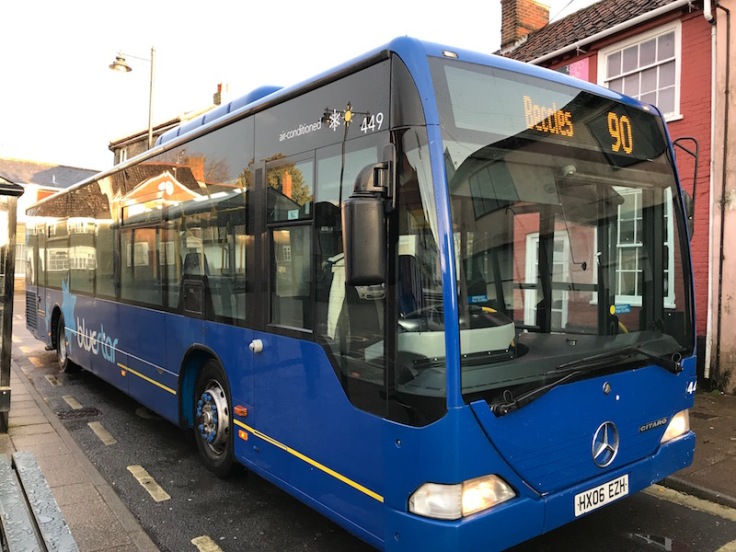 The journey on the Konectbus 88 (soon to be a First Bus 99A) between Halesworth and Southwold at 1023 had just two passengers on board while the afternoon peak journey on route 90 leaving Southwold at 1638 travelled all the way to Halesworth via Beccles (a journey of 1 hour and 17 minutes) carried just two other passengers besides me and the driver and then only between the hamlet of Willingham and Beccles – a journey of around ten minutes. Border Bus have announced they’ll be stepping in to run partial replacements for the withdrawn 90 with new services 522 and 524 but with paucity of numbers travelling it’s a bleak future. Unsurprisingly a significant role is played by community transport in this region.
The journey on the Konectbus 88 (soon to be a First Bus 99A) between Halesworth and Southwold at 1023 had just two passengers on board while the afternoon peak journey on route 90 leaving Southwold at 1638 travelled all the way to Halesworth via Beccles (a journey of 1 hour and 17 minutes) carried just two other passengers besides me and the driver and then only between the hamlet of Willingham and Beccles – a journey of around ten minutes. Border Bus have announced they’ll be stepping in to run partial replacements for the withdrawn 90 with new services 522 and 524 but with paucity of numbers travelling it’s a bleak future. Unsurprisingly a significant role is played by community transport in this region.
5 Community Transport
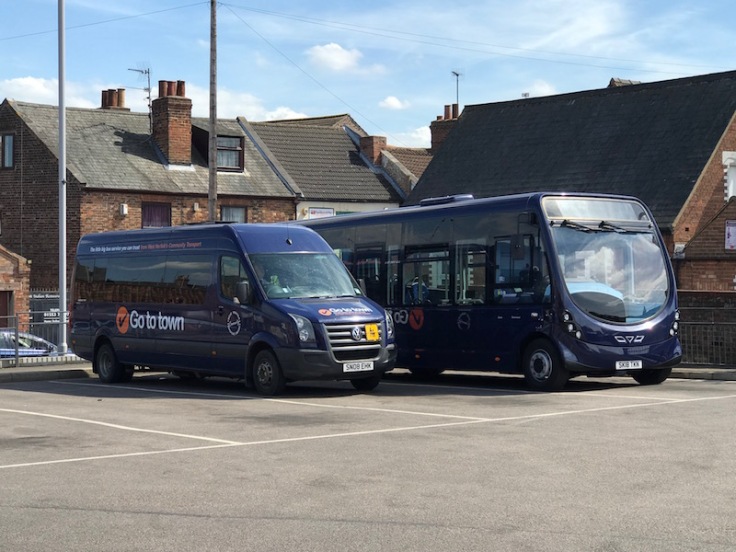 It’s interesting to see up in West Norfolk one of the beneficiaries of the Stagecoach pull out in Kings Lynn has been West Norfolk Community Transport (WNCT) who’ve expanded their ‘Go to town’ branded bus routes, which now provide a significant part of the town’s bus network. It’s also interesting to see Ben Colson who owned and ran Norfolk Green heavily involved in WNCT who, with the already mentioned Julian Paterson and Andrew Pursey are three key people in making the Anglian bus scene a success. It also shows you can’t keep a good busman down; they just pop up in another exciting bus venture. Indeed Andrew also volunteers on the Committee of the Beccles and Bungay Community Transport who I had the pleasure of spending the whole of yesterday morning with travelling around their Wednesday only three rural bus routes between Halesworth and Beccles, all using the number 532.
It’s interesting to see up in West Norfolk one of the beneficiaries of the Stagecoach pull out in Kings Lynn has been West Norfolk Community Transport (WNCT) who’ve expanded their ‘Go to town’ branded bus routes, which now provide a significant part of the town’s bus network. It’s also interesting to see Ben Colson who owned and ran Norfolk Green heavily involved in WNCT who, with the already mentioned Julian Paterson and Andrew Pursey are three key people in making the Anglian bus scene a success. It also shows you can’t keep a good busman down; they just pop up in another exciting bus venture. Indeed Andrew also volunteers on the Committee of the Beccles and Bungay Community Transport who I had the pleasure of spending the whole of yesterday morning with travelling around their Wednesday only three rural bus routes between Halesworth and Beccles, all using the number 532.
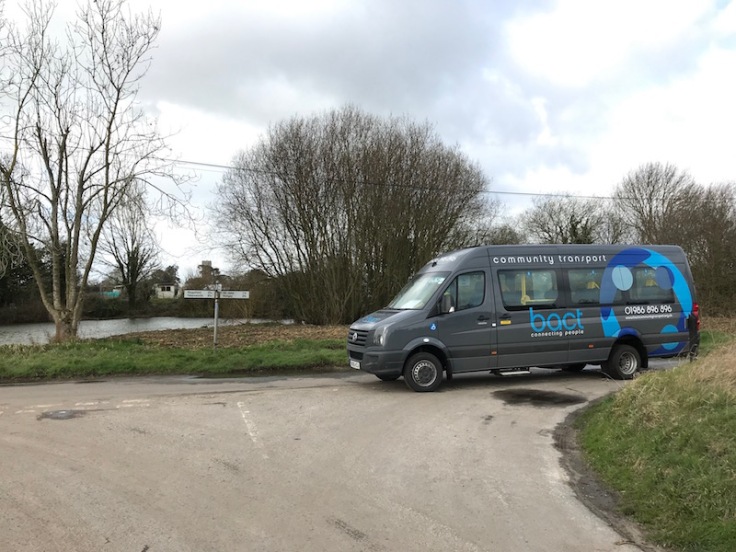 I’d been recommended to travel on the routes by blogger Steve’s Bus & Train Page on Twitter (@busandtrainpage) and how right he was to encourage me to give them a try. I also found out another Twitter stalwart Tim Miller (@banditman59uk) is a relief driver for the route when regular Mick has a day off.
I’d been recommended to travel on the routes by blogger Steve’s Bus & Train Page on Twitter (@busandtrainpage) and how right he was to encourage me to give them a try. I also found out another Twitter stalwart Tim Miller (@banditman59uk) is a relief driver for the route when regular Mick has a day off.
Driver Mick is a real gem. His knowledge of Suffolk is impressively huge. Being a local lad he regaled me with fascinating insights and information about the area as we travelled around.
 The Wednesday only route 532 really is a ‘lifeline bus service’. Yesterday around a dozen people travelled on the first journey from Laxfield, Heveningham and Huntingfield north into Halesworth for a morning’s shopping and other commitments. Two stayed on the bus for the next journey which runs via Brampton, Willingham, Sotterley, Wrentham, Rushmere and Mutford to Beccles which I joined.
The Wednesday only route 532 really is a ‘lifeline bus service’. Yesterday around a dozen people travelled on the first journey from Laxfield, Heveningham and Huntingfield north into Halesworth for a morning’s shopping and other commitments. Two stayed on the bus for the next journey which runs via Brampton, Willingham, Sotterley, Wrentham, Rushmere and Mutford to Beccles which I joined. 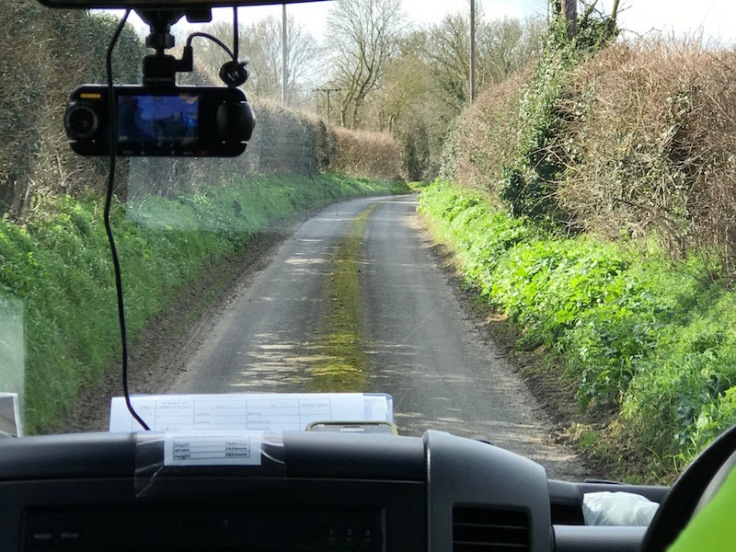 A lovely couple boarded along this part of the route with the husband helping Mick out to provide a commentary by adding historical background to the sights we passed – which were mainly churches – an amazing number too – all told, we passed 21 churches yesterday morning, some with just a few houses nearby. The one pictured below, a paticularly fine example, at the end of the route in Laxfield. As you can see, even the cars park in a colour coordinated way, the village is so pretty!
A lovely couple boarded along this part of the route with the husband helping Mick out to provide a commentary by adding historical background to the sights we passed – which were mainly churches – an amazing number too – all told, we passed 21 churches yesterday morning, some with just a few houses nearby. The one pictured below, a paticularly fine example, at the end of the route in Laxfield. As you can see, even the cars park in a colour coordinated way, the village is so pretty!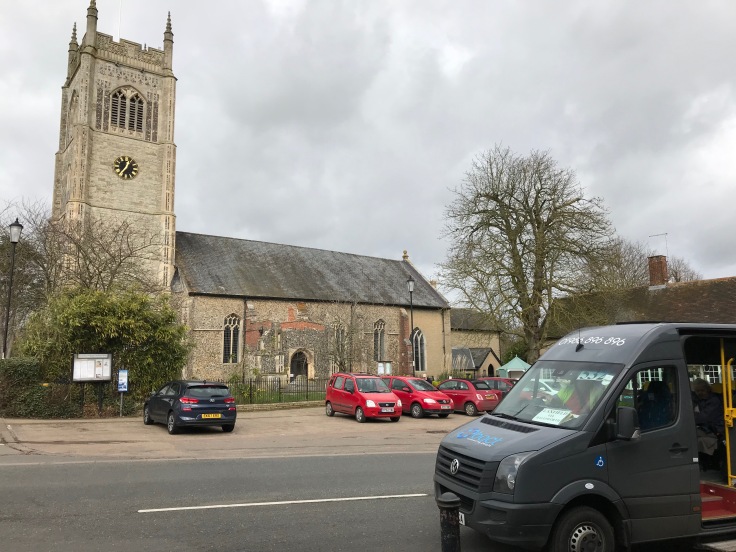 After dropping our four shoppers off in Beccles from that trip it was time for Mick’s third run of the day back to Halesworth via even more tiny micro hamlets and churches (and the odd water tower) including Ilketshall St Andrew, Ilketshall St Margaret, St Peter South Elmham, All Saints South Elmham (you get the idea this used to be a very religously devout area!) and finally Rumburgh and Wissett; we picked up four regulars along the way who all had an hour and twenty minutes in Halesworth before return time, while we continued back to Laxfield to take ten passengers back home who’d come in on the first journey, bringing one regular back into Halesworth on the return.
After dropping our four shoppers off in Beccles from that trip it was time for Mick’s third run of the day back to Halesworth via even more tiny micro hamlets and churches (and the odd water tower) including Ilketshall St Andrew, Ilketshall St Margaret, St Peter South Elmham, All Saints South Elmham (you get the idea this used to be a very religously devout area!) and finally Rumburgh and Wissett; we picked up four regulars along the way who all had an hour and twenty minutes in Halesworth before return time, while we continued back to Laxfield to take ten passengers back home who’d come in on the first journey, bringing one regular back into Halesworth on the return. Mick was off back to Beccles via the All Saints route but I left him there having completed the full circuit and having thoroughly enjoyed it too. One of the regulars who boarded in Wissett followed me into the library at Halesworth to find out more about why on earth someone from Brighton was riding around Suffolk’s rural countryside and we got chatting about the problems of rural buses and her concerns at being stranded if Suffolk County Council were to cut this vital once a week route. Apparently it’s up for review soon as the conract ends in the summer.
Mick was off back to Beccles via the All Saints route but I left him there having completed the full circuit and having thoroughly enjoyed it too. One of the regulars who boarded in Wissett followed me into the library at Halesworth to find out more about why on earth someone from Brighton was riding around Suffolk’s rural countryside and we got chatting about the problems of rural buses and her concerns at being stranded if Suffolk County Council were to cut this vital once a week route. Apparently it’s up for review soon as the conract ends in the summer.
Encouragingly this minibus had carried the most passengers of all the tendered bus routes I’d travelled on during the last few days and I do hope her fears can be allayed. Suffolk County Council should be well pleased with the support the ‘BACT’ community transport receives from passengers as well as the great personal service Mick provides. Long may it continue. It’s a good example of how buses can continue to provide deep rural transport without the need to come up with new fangled ideas like app based DRT – just fund and run a scheduled low cost once or twice a week community minibus. Sorted.
Indeed the town route 511 in Halesworth is also operated by Community buses, this one by the locally based Halesworth Community Transport.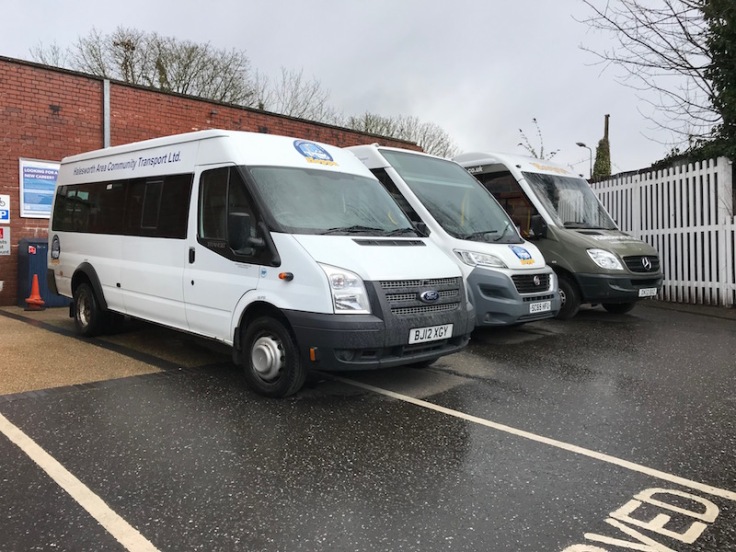
6. A couple of final thoughts
Firstly Suffolk County Council are reportedly considering saving £100,000 by ceasing to update and post bus stop timetables and information. This would be a huge mistake. Such information is vitally reassuring particularly for strangers like me to an area. Suffolk’s presentation is excellent – don’t change it.
 Secondly there’s a vital need for East Anglia to follow Kent/Surrey/Sussex’s lead in establishing an all bus operator day ticket like the latter’s Discovery ticket. With a variety of small bus companies and a few larger ones (Ipswich Buses, First Bus and Arriva) it really would make for a passenger friendly way of travelling around rather than having restricted ticket availability to each operator. You need every passenger you can get – don’t make it hard. Perhaps Suffolk County Coiuncil could initiate discussions on such a proposal?
Secondly there’s a vital need for East Anglia to follow Kent/Surrey/Sussex’s lead in establishing an all bus operator day ticket like the latter’s Discovery ticket. With a variety of small bus companies and a few larger ones (Ipswich Buses, First Bus and Arriva) it really would make for a passenger friendly way of travelling around rather than having restricted ticket availability to each operator. You need every passenger you can get – don’t make it hard. Perhaps Suffolk County Coiuncil could initiate discussions on such a proposal?
Roger French


Very interesting read. Go-Ahead seemed to completely misunderstand the nature of the companies that they acquired in East Anglia. The imposition of big company procedures seemed to increase costs but without corresponding benefits.
Although Hedingham had a lot of old (but well maintained) deckers for schools work, the bus services were run with modern low floor buses mostly bought new. Since Go-Ahead took over in 2012, not one brand new vehicle has been bought for Hedingham.
Employees were alienated by a ban on taking buses to rallies whereas nothing pleased the company’s founder more than a driver coming in on a Monday morning with a shiny cup for winning an award at a rally the previous day. And if a few enthusiasts had made a donation for travelling to the rally on the bus, that was even better!
LikeLiked by 1 person
What a shame to read this. Missed opportunities for some good PR and staff motivation.
LikeLike
Hello Roger,
A good write up, well done.
As an Essex Bus Driver with First at Basildon, it was so disappointing to read that we seem to be consistent in regularly getting things wrong and in particular looking, Warn, Torn & Tired. It’s so disheartening as an employee to turn up for work looking Smart & Presentable to find you’ve a Dirty Bus. As a Driver it’s also so important to arrive on time at the vehicle and to at least allow people to board so that they can, (Settle Down) for the journey. We both agree and recognise how image is important. I’m disappointed also in Go-Ahead’s appearance. Having worked for them in different situations over my past 30+ Years Bus Career, I have seen them at their very best. They did wonders when they first purchased Metro Bus and saved the day when they stepped in at Crawley after Arriva decided to abandon the area. I never forget when I was a Unite Union official and conducting pay talks with my MD at the time Mr John Trainor.
Mr David Brown sat in on the meeting briefly after soon returning when his spell of employment ended with TfL.
He made an off the cuff remark which I will never forget,
“ We are not a Charity, we are a Company and here to make a profit “. Sadly this seems to be the view of most big Operators. I’m sticking it out at First Bus, but remaining Geographically close to London because I genuinely fear the loss of future Bus Work outside of the Capital. I’m warning my customers of the impending Local Bus Consultation document that is currently available at the Basildon Town Centre Council Offices. I’ve read it and quite frankly shocked at how they’ve presented the document. I can read between the lines and can see a mass of cuts in the making. Thank You again for highlighting basic mistakes by the larger Bus Operators. It seems they don’t or even can’t be bothered to listen or change.
I know they don’t always get it wrong, but it’s mostly never getting it, “Right”.
On a final note, I’ve never been so disheartened by hearing and experiencing so much negativity with my Work colleagues. Many seem to have just given up. I was laughed at the other day when on a CPC course, interestingly named ( Better Journeys ) by First Bus, when a few were making the same old negative remarks, mainly about how Customers are a pain. They don’t seem to, “Get”, who pays their wages.
Anyway, I piped up regards a famous saying made by the American President Jack Kennedy in Berlin.
I changed it to, “Its not What Your Company can do for You, but what You can do for Your Company ? “. Sadly it seems I’m an oddball in this respect.
Please keep up the good work. It’s interesting to read and good points are always placed in your reporting.
Kind regards,
Mark Gosney
LikeLiked by 1 person
Many thanks Mark and fascinating to read your observations and experiences. You’re quite right about the link between fleet presentation and staff morale and motivation – and it’s quite simple to get right really. Keep up the good work – sounds like you’re an excellent member of staff to have around.
LikeLike
The 532 reminds me of the now closed Nightingales of Beccles who operated the original route and always used one of their seemingly never-ending supply of ancient rickety beavers which was great to travel on!
In regards to the 532 under threat of closure Suffolk CC has, actually, already withdrawn that service in the past (during the massive April 2011 cuts) only to be reinstated a few years later (operating Wednesday only instead of Mon-Fri and not to Lowestoft) if I’m not mistaken. I imagine it’s a prime target again for SCC in the near future – unfortunately if cuts need to be made they’re more than happy to withdraw a well patronised route especially if full of freedom pass users (I doubt they even look at passenger loadings for rural routes even). The market day routes from rural areas to towns (such as the withdrawn 569 from Framlingham to Norwich) are good examples given they would generally fill much of a coach yet still all got the axe in 2011. I reckon they see these routes just as a double burden rather than something to protect – the days of buses in villages like Laxfield are probably numbered. Anyway the few deep rural routes which still run, as you say, are really great fun to travel on – good to see attention go to them!
Anyway Wayback Machine has captured the April 2011 cuts page if you’re interested:
https://web.archive.org/web/20111118050140/http://www.suffolkonboard.com/news/bus_service_news/passenger_transport_service_changes/april_bus_service_changes
LikeLiked by 1 person
Thanks very much for that very interesting background and observations.
LikeLike
But would First be interested in the Queens Road deal you suggest? And, despite the independents you mentioned, would there be many takers amongst the independent community for the Go Ahead operations?
I firmly believe that we are rapidly heading towards a time when a large, but unviable area will cease to have a bus service due to no operator having the desire to continue there!
LikeLiked by 1 person
You could be well be right.
LikeLike
There seems to be a huge disconnect in many rural areas between what service is provided and what service is required by passengers. I’m going to be contraversial here and say that, in my opinion, the current rural bus model as a service for all comers has had its day, and that it should be put out of its misery now.
I’ll go further, and say that the car (outside the big conurbations) has won, and we should recognise that and act accordingly.
That’s not to say that there should be “no service”, but maybe we should actually be looking at three tiers of rural bus service now:
Tier One: school services, tailored specifically for the local secondary school (or maybe more than one school), but available for other passengers as well. This will require (a) services being properly available for all passengers, with BSOG available (unlike now, where, unless actual (and substantial) usage by adults can be proved, the grant is not paid). It will also mean that said services operate 253/365 days per year, and not just 190/365 days. It may also mean that schools should co-ordinate start/finish times better, so one bus CAN serve more than one school.
Tier Two: shoppers services to the appropriate local town, and also including the local superstore (like it or not, there are here to stay, and town centres aren’t the only destination any more). If at all possible, said shoppers services should run every Monday-Friday, and should be timetabled such that two services can be operated by the one bus and driver. IF and only IF there is sufficient demand, these services could operate on Saturdays for the young people who have no access to a car.
Both Tier One and Tier Two services should be operated by the same vehicle; this vehicle should be fully accessible AND the scholars may just need to stand!! All too often, school buses have to be operated by seat-belted vehicles, which don’t provide full accessibility (and the little darlings don’t use the belts anyway!!).
Tier Three: IF and only IF appropriate demand is there, “commuter-time” services should operate as required. In practice commuters use the family car to allow for flexible-time working, and no passenger will wait for 2-3 hours for a bus if they finish work early.
Maybe Dorset CC actually had the right idea . . . . if demand isn’t there, then withdraw the bus.
For any other services, then use the “community” sector, but watch out . . . . if the S19/S22 furore goes to its logical conclusion, costs for this sector will rise as PCV drivers are required and vehicles need more maintenance inspections . . . . . unless the “Colson’s” or “Cuckmere’s” of this world are involved, Community Operators will simply close down.
So, in summary . . . . improve and enhance Park and Ride offerings, such that they’re irrestistable to car drivers . . . . stop wittering on about rural evening and Sunday bus services; they simply won’t have enough regular ridership to survive . . . . . restructure networks such that schools and shoppers services are co-ordinated (and will probably become almost commercial or just need a small subsidy). The days of substantial Council subsidies are gone, and won’t return, and the sooner we recognise that, the better.
Oh, and yes, Mr French is right . . . . encourage the smaller operators to remain in the local bus sector, and encourage the plc’s to stick to what they do (generally) well (which is to run frequent, quality networks in big towns) and stop looking for rural opportunities, which they will run badly and eventually close down.
I started work with LCBS in 1975, and to my mind this is the last and final chance for rural bus services; indeed, we are probably too late in most cases now. We need to concentrate on urban and inter-urban services now, to make sure we don’t lose those as well.
LikeLiked by 1 person
That makes a lot of sense . Many thanks for your contribution.
LikeLike
Looking at the Chambers Twitter feed, a significant number of journeys didn’t run on Saturday 16th due to “driver shortage”. You just cannot do this with a rural service and hope to retain passengers
LikeLiked by 1 person
Poor show.
LikeLike